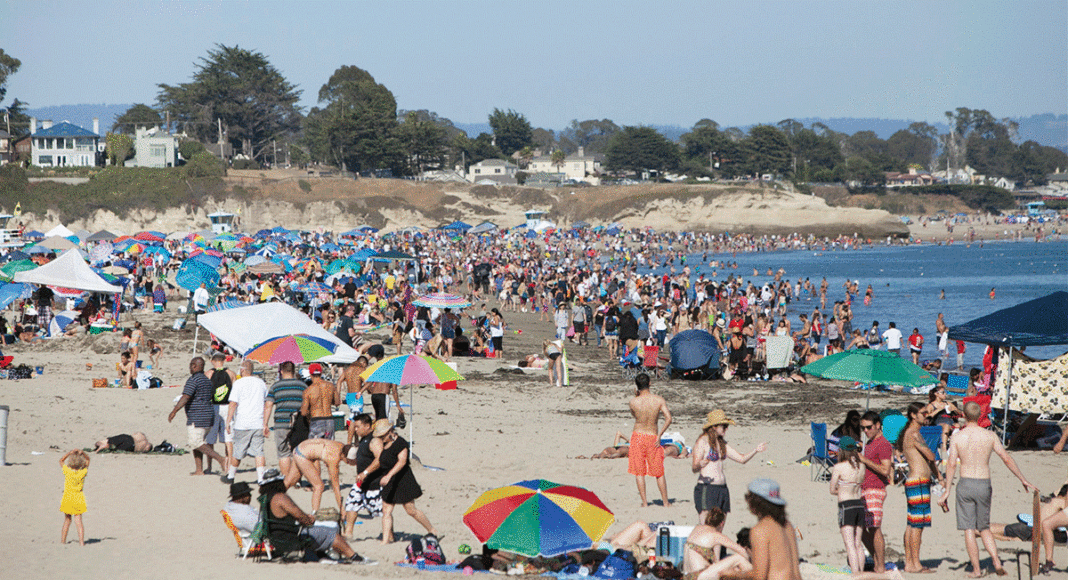James Alamillo, of the nonprofit Heal the Bay, says that no matter how poor the water is under the Santa Cruz Municipal Wharf, swimmers and surfers in that area should be OK—so long as they pick their spots carefully.
Alamillo, who graduated from UCSC in 1992, has fond memories of his days living near Water Street and Branciforte Avenue, and, to this day, he cringes to think of the once-beloved Elf Land, in Upper Campus, getting clear-cut to make room for colleges 9 and 10.
Still, this year’s press release announcing the report card—which came out last month, a couple weeks late this year—plainly states that Cowell Beach is the third-worst beach in the state, an improvement over previous years. The release makes no mention of the wharf.
“In that case, that is on us,” he says, “so I apologize for that.”
To be fair, the report card’s brief online summary does specify that the troubled site is “west of the wharf,” but still doesn’t explain what that really means. Nor does it say just how tiny the problematic region is. Buried in the full 75-page report card, though, the listings mention 13 coastal testing spots, including two nearby—known as “Cowell Beach, Lifeguard Tower” and “Santa Cruz Main Beach at the Boardwalk.” Both of those passed, as they usually do, with flying colors. And both are within a couple hundred feet of the wharf.
Confused about the safety of the water, Cowell Surf Shop Owner Kathy Pappas hopes environmental nonprofits and government officials can get on the same page and be more publicly straightforward about the limited scope of the problems. She wishes the public-health warnings that are often posted at the beach would make that more specific.
“That would be so much more clear, because people come in here and they say we heard the beach is polluted, and it gives us a bad reputation,” says Pappas, who sometimes isn’t sure what to believe herself.
The results do fluctuate.
Parks employees have been stapling chicken wire under the wharf to deter pooping pigeons, who like to roost under the pier and may be the biggest contributor to the water quality issues. As of Thursday, even the water by the wharf had good results, prompting the health advisory signs warning against water contact and ingestion to come down, at least for now.
This year’s report card also gave slightly better grades for coliform levels to Cowell than to a site at Capitola Beach, west of the jetty. And yet Cowell beach came in ranked four spots higher—or dirtier—than Capitola. There is more to that than numbers, though.
“There is a certain amount of subjectivity, looking at the Beach Bummer list,” Alamillo admits. “And the some of that stems from where do you put the grade’s weight? Do you put it on the summer season? Or on the year-round season? I would put more weight on the summer season and a beach having more visitors.”
He adds that Heal the Bay took the beach’s recent history of failed results into account, as well.
(Thinking aloud, Alamillo suggests Heal the Bay might want to start studying beaches near piers to see if they always perform worse, because other bad beaches appear to be near such structures, too.)
Water Resources Division Director John Ricker oversees the part of the county health department responsible for water testing. He says that although they’re working to improve the quality, someone would probably have to swim under the pier and start drinking a bunch of ocean water in order to get sick. And even then, the salt would probably upset their stomach before the bacteria did. State regulators developed the testing standards for human sewage, and trace amounts of animal waste are far less dangerous.
Akin Babatola, laboratory and environmental compliance manager for the city, told GT in May that the county’s Colilert tests are “flawed” and therefore the rankings are too. The tests, he says, can show an alarmingly high number of coliforms, and it’s impossible to tell if those organisms are the bad ones, like E. coli, or good ones, found in a thriving ecosystem.
Alamillo is skeptical. He argues that everyone has always known the Colilert tests have problems, but agencies signed off on them years ago, because they were cheap and easy. Differing levels of coliforms at different beaches amounts to nothing more than a statistical variance, he says, that should even out over time.
“How do I put this correctly? Everyone’s right—how about that? What I mean by that, he’s nitpicking on something that was known ever since Colilert was implemented,” he says.
Ricker concurs that alternative tests are more expensive, adding that no tests are 100-percent accurate.
But Babatola contends that the tests aren’t more expensive. When he worked for the city of San Jose 23 years ago, one of his employees wrote a dissertation proving that the more precise microfiltration method is actually no more expensive, he says. The only perceived cost difference is that a microbiologist with a degree must administer such a test, which he says is standard practice for water quality testing, anyway. He adds that the city has been doing microfiltration, collaborating with the Cowell Working Group, which formed a couple years ago to clean up water quality. Those results show that the total coliforms are very high, compared with the amounts of E. coli near the wharf—a trend he doesn’t see at other city beaches, he says.
Reached for follow-up, Alamillo says that, if microfiltration is so superior, maybe local officials should start using it for all of their official reporting on local beaches.
“All we’re doing is using their data to then give to the public in a unified method that they can understand,” he says. “We’re all for it.”













